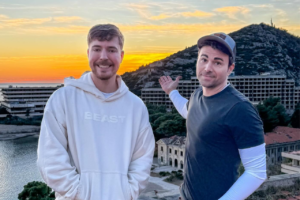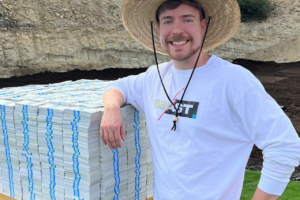In the gleaming landscape of digital entrepreneurship, where content creators often struggle to expand beyond their initial platform success, Jimmy Donaldson’s strategic approach to empire-building stands as a masterclass in thoughtful diversification. Like a master chess player thinking several moves ahead, Donaldson has carefully structured his business around three distinct pillars: a content studio, consumer packaged goods (Feastables), and software development—each serving as both a standalone venture and a symbiotic component of a larger vision.
The content studio, anchored by his phenomenally successful YouTube presence, has evolved far beyond simple video production. With the launch of “Beast Games” on Amazon Prime, Donaldson demonstrates how creator-led content can transcend platform boundaries while maintaining its essential DNA. “You can’t find anything even a third as big as ours anywhere else,” Donaldson notes, highlighting how his team’s expertise in spectacular content creation translates across mediums. This expansion, however, comes with its own set of challenges—managing a team that has grown from 19 to 400 people, coordinating massive productions, and maintaining quality across multiple platforms.
Perhaps most intriguingly, Donaldson’s venture into consumer packaged goods through Feastables represents not just a business expansion, but a mission-driven enterprise. Unlike many creator-launched products that spike initially and then fade into obscurity, Feastables approaches the chocolate industry with a revolutionary commitment to ethical sourcing. “We’re the largest ethically sourced chocolate company in America,” Donaldson states, revealing how this venture has led him to tackle systemic issues in West African cocoa farming, including child labor and poverty.
The third pillar, software development, showcases Donaldson’s understanding of the creator economy’s infrastructure needs. Through projects like View Stats, he’s addressing the tools and analytics gaps that creators face, demonstrating how personal pain points can evolve into industry solutions.
What sets Donaldson’s empire apart is not just its scale, but its intentional structure. Each venture feeds into and strengthens the others—content drives awareness for products, ethical business practices provide compelling storytelling opportunities, and software solutions support the broader creator ecosystem. This synergy hasn’t happened by accident; it’s the result of careful planning and a willingness to take calculated risks while maintaining core operations.
The lessons here for aspiring creator-entrepreneurs are clear: successful scaling requires more than just launching products under a personal brand. It demands strategic thinking about how different ventures can complement each other, a commitment to solving real problems, and the infrastructure to support sustainable growth. As Donaldson puts it, “I want to build businesses that are net positives and then use the studio to get the attention to grow them.”

This approach to empire-building represents a maturation of the creator economy itself—a shift from individual content creation to comprehensive business ecosystems that can drive both profit and positive change. In Donaldson’s vision, success isn’t measured solely by views or revenue, but by the lasting impact his ventures can have on their respective industries.
In the ever-evolving landscape of digital entertainment, where the lines between traditional media and new-age content continue to blur, Mr Beast’s “Beast Games” emerges as a fascinating case study in ambitious production scale and strategic content distribution. The show’s development reveals the delicate dance between YouTube’s instant gratification model and the measured pacing of traditional television—a balance that could reshape how we think about entertainment in the streaming era.
At the heart of this transformation lies an audacious vision: a competition show featuring 1,000 contestants, a scale unprecedented in television history. The logistics alone paint a picture of controlled chaos—imagine coordinating bathroom breaks for a thousand people, managing an army of GoPros capturing every moment, and orchestrating the complex ballet of getting contestants in and out of massive sets. “Just being there was overwhelming with a thousand people,” Donaldson reflects, highlighting how the sheer magnitude of the production pushed the boundaries of what’s possible in entertainment.
The show’s release strategy represents a particularly intriguing departure from the binge-watching model that has dominated streaming for the past decade. In choosing to release episodes weekly, Donaldson and Prime Video are betting on the power of collective viewing experiences. “If you just binge it and it ends, there’s nothing to really discuss,” Donaldson explains, emphasizing how weekly releases create space for audience engagement and community building—a dynamic reminiscent of television’s golden age but reimagined for the digital era.
Perhaps most fascinating is how “Beast Games” navigates the tension between YouTube’s algorithmic demands and traditional storytelling. On YouTube, creators must front-load their content with spectacular moments to retain viewers in those crucial first seconds. In contrast, “Beast Games” allows itself to breathe, opening with an uninterrupted 12-second shot of Donaldson—an eternity by YouTube standards. This subtle shift speaks volumes about the different viewer expectations across platforms.
The production challenges revealed themselves in unexpected ways. From managing CGI elements (including an unplanned moat that appeared in post-production) to coordinating hundreds of editors, the project demanded a new level of organizational complexity. Yet these challenges also sparked innovation, leading to novel approaches in how reality competition shows can be produced and presented.
The show’s character development strategy particularly illustrates this evolution. While early episodes focus on spectacular eliminations and grand-scale challenges, the series gradually deepens its emotional investment in contestants. “Around episode three… people have like a 70% chance of finishing it,” Donaldson notes, highlighting how the show builds viewer commitment through carefully paced storytelling—a stark contrast to YouTube’s immediate gratification model.
This approach to entertainment production represents more than just a scaling up of YouTube content; it’s a reimagining of how digital creators can engage with traditional media formats while maintaining their authentic appeal. The result is a hybrid form of entertainment that honors both the spectacle-driven nature of YouTube and the character-driven narratives of traditional television.
As “Beast Games” demonstrates, the future of entertainment may not lie in choosing between digital and traditional formats, but in finding innovative ways to blend their best aspects. It’s a reminder that even as production scales reach new heights, the fundamental goal remains unchanged: creating compelling stories that bring people together in shared experiences.
In the sun-drenched cocoa fields of West Africa, where the world’s chocolate story begins, a remarkable transformation is taking place—one that challenges our assumptions about the intersection of creator-led businesses and ethical commerce. Through Mr Beast’s Feastables venture, we witness how digital influence can catalyze meaningful change in traditional industries, offering a blueprint for conscious capitalism in the creator economy.
The journey began, as many do, with an uncomfortable truth. While building his chocolate company, Donaldson discovered the disturbing reality of child labor in West African cocoa farming—a practice so normalized that it had become nearly invisible to the industry. “Over a million kids in child labor in West Africa on cocoa farms,” he reveals, the gravity of his voice matching the weight of the statistics. “When I had been running a chocolate company for a while and I didn’t even know any of that because everyone just kind of paints it as not a big deal.”

Rather than retreat from this challenge, Donaldson’s response illustrates how creator-led businesses can approach systemic problems differently. Working in partnership with Tony’s Chocolonely, a pioneer in ethical chocolate sourcing, Feastables established a comprehensive approach centered on a simple yet powerful principle: paying farmers enough to make ethical choices viable.
The mechanics of this transformation are both practical and profound. Through a “living income reference price,” Feastables ensures farmers earn enough to hire adult workers, breaking the economic cycle that perpetuates child labor. This isn’t charity—it’s strategic business redesign. The company provides farming coaches to improve yield, conducts regular audits, and, most remarkably, invests in building schools in villages where educational infrastructure is lacking.
What makes this approach particularly noteworthy is its scalability. Unlike many creator-launched products that prioritize short-term gains, Feastables is building for long-term impact. “If we can get it where Feastables is doing over a billion dollars a year in revenue while paying our farmers a living income while doing all these ethical things—and while being profitable—then we can look at other companies and say, ‘Stop using child labor,'” Donaldson explains.
This 18-month journey, largely conducted away from public view, represents a new model for creator-led businesses. It suggests that the real power of digital influence lies not in selling products but in reimagining how industries operate. The silent work of building schools, training farmers, and restructuring supply chains may not generate viral content, but it creates lasting change.
For creators contemplating their own business ventures, Feastables offers valuable lessons. Success in the creator economy doesn’t have to mean choosing between profit and purpose—it can mean using one’s platform to solve fundamental problems while building sustainable businesses. As Donaldson notes, “I want to build these businesses that are net positives and then use the studio to get the attention to grow them.”
The story of Feastables reminds us that in the creator economy, the most powerful currency isn’t views or likes—it’s the ability to effect real-world change. As digital influence continues to reshape traditional industries, perhaps the most valuable question creators can ask isn’t “How can I sell more?” but “How can I solve problems at scale while building a sustainable business?”
In the rapidly evolving landscape where digital creators and traditional media increasingly intersect, a new paradigm is emerging—one that challenges our conventional understanding of how content creators can transition between platforms while maintaining their authentic appeal. Through Mr Beast’s candid insights about his Amazon Prime venture, we glimpse the future of cross-platform storytelling and the delicate art of platform adaptation.
The journey from YouTube to streaming platforms represents more than just a change in distribution—it’s a fundamental shift in how creators must think about their content and audience engagement. “On YouTube, you have to reassure them the title and thumbnail is real,” Donaldson explains, highlighting how platform-specific audience expectations shape content strategy. “You have like this second window to convince someone I did this, I did this, I did this, I swear to God I did it.”
This contrast becomes particularly striking when examining how “Beast Games” approaches storytelling. While YouTube demands immediate validation and spectacle, streaming platforms offer the luxury of patience. A single 12-second uncut shot opening “Beast Games” would be unthinkable on YouTube, yet on Prime Video, it serves as a powerful statement about the show’s cinematic ambitions.
For creators contemplating similar transitions, Donaldson offers crucial advice about negotiations with streaming platforms. “There are people who have negotiated hundreds or thousands of these streaming deals,” he notes, emphasizing the importance of expert guidance. The complexity extends beyond simple monetary terms to include creative control, IP ownership, and various rights that many creators might not even consider.
Perhaps most importantly, Donaldson advocates for maintaining what makes a creator unique while adapting to new formats. “Streaming shows make sense if you take what your community loves about you and why your community likes you plus your area of expertise and zone of genius, and then you modify it towards a streaming show,” he explains. This philosophy suggests that successful platform transitions aren’t about abandoning one’s creative identity but rather about translating it effectively.
The weekly release strategy for “Beast Games” represents another fascinating experiment in audience engagement. In an era where binge-watching has become normalized, the decision to release episodes weekly speaks to a larger trend of recreating appointment viewing for the streaming age. This approach allows for community discussion and speculation between episodes—a dynamic that’s often lost in the binge model.
For creators considering similar ventures, Donaldson’s experience offers several key lessons:
– The importance of maintaining creative control while adapting to new platform requirements
– The value of expert guidance in navigating complex deal structures
– The need to balance immediate gratification with longer-form storytelling
– The potential benefits of traditional release schedules in building community engagement
As the lines between digital and traditional media continue to blur, creators face both unprecedented opportunities and challenges. Success in this new landscape requires more than just content creation skills—it demands strategic thinking about platform differences, audience expectations, and the delicate balance between maintaining authenticity and adapting to new formats.
The evolution of the creator economy isn’t just about individual success stories; it’s about establishing new models for how digital talent can expand their influence while staying true to their creative vision. As Donaldson’s experience shows, the future belongs to those who can successfully bridge the gap between platforms while maintaining the unique connection with their audience that made them successful in the first place.

In the glittering world of social media, where success stories often read like modern fairy tales, the reality of scaling creator businesses presents a far more nuanced narrative. Through Mr Beast’s candid insights, we discover a sobering yet essential perspective on the challenges and misconceptions that plague creator-led ventures—particularly in the consumer packaged goods (CPG) space.
The allure is undeniable. The math seems deceptively simple: leverage an existing audience to reduce customer acquisition costs, launch a product, and watch the revenue flow in. Yet, as Donaldson reveals, this surface-level analysis misses the profound complexity of building sustainable businesses. “There’s so much more to a company, especially a CPG company, than just having a product,” he explains, painting a picture of an intricate ecosystem where product placement, pricing strategy, and inventory management form just the tip of the iceberg.
Consider the cautionary tale of Donaldson’s early Feastables launch, where a seemingly minor issue with box design led to products falling out of their packaging—a mistake that cost “tens of millions of dollars” to rectify. This anecdote illustrates a crucial truth: the skills that make someone a successful content creator don’t automatically translate to operational excellence in traditional business sectors.
The pattern is distressingly common in the creator economy: a successful launch followed by a precipitous decline in sales. “You literally just see in their sales graphs it goes up and then nose-dives,” Donaldson observes. This trajectory reveals a fundamental misunderstanding of what constitutes a sustainable business. As he pointedly notes, “A business isn’t getting someone to buy a bottle of jelly once. A business is getting someone to buy that bottle of jelly every two months for the next 10 years.”
For creators contemplating business ventures, Donaldson offers a refreshingly pragmatic alternative: consider brand partnerships over product launches. The math is compelling—a creator with 10 million subscribers might earn $50,000 per branded video, potentially accumulating $1.5 million over four years through strategic partnerships. This approach offers a lower-risk path to monetization while allowing creators to focus on what they do best: creating content.
The lessons extend beyond mere cautionary tales. For those determined to build businesses, Donaldson emphasizes the importance of expert partnerships. “Partner with someone who is an expert in the field, have them run the business, and you just kind of do the marketing,” he advises. This approach acknowledges both the creator’s strengths and the specialized expertise required for successful business operations.
Perhaps most importantly, Donaldson highlights the often-overlooked impact on content quality when creators stretch themselves too thin. The pursuit of business ventures can inadvertently undermine the very platform that enabled their success. “Anything past that, you’re just going to destroy your YouTube channel, or it’s just going to fail,” he warns, underlining the delicate balance between content creation and business expansion.
The future of creator-led businesses isn’t necessarily bleak, but it demands a more sophisticated approach than many currently employ. Success requires understanding that building a sustainable business involves more than leveraging influence—it requires infrastructure, expertise, and a long-term vision that extends beyond initial sales spikes.
For creators standing at this crossroads, the message is clear: approach business ventures with eyes wide open, prioritize sustainable growth over quick wins, and never underestimate the complexity of building something that lasts. In the end, the most successful creator businesses might be those that recognize what they don’t know—and aren’t afraid to seek help in filling those gaps.
In the vibrant tapestry of global digital entertainment, India emerges as a fascinating case study of untapped potential and cultural dynamism. Through Mr Beast’s experiences and observations, we gain unique insights into a market that simultaneously represents both the future of digital content and the challenges of monetization in emerging economies.
The numbers tell a compelling story. For Donaldson, India represents his second-largest audience outside the United States, illustrating the country’s massive appetite for digital content. Yet what’s most intriguing isn’t just the scale, but the parallel universe of content creators who command audiences that would be the envy of many Western influencers, while remaining virtually unknown outside their homeland.
“I’d look at their Channel and be like, this guy’s pulling 20 million views a video, I’ve never even heard of him before,” Donaldson recalls of his encounters with Indian creators. This phenomenon reflects a unique aspect of the global creator economy—the existence of content powerhouses whose influence, while immense, remains geographically contained due to language and cultural specificity.
The mechanics of this containment are fascinating. Many Indian creators employ a distinctive bilingual approach, seamlessly weaving between English and Hindi within their content. While this serves their immediate audience perfectly, it creates a natural barrier to global expansion. As Donaldson notes, “If you’re not in India, you literally just don’t get served their content,” highlighting how platform algorithms reinforce these geographic boundaries.
However, the story becomes more complex when examining monetization. Despite commanding audiences that rival or exceed their Western counterparts, Indian creators face unique challenges in converting views to revenue. The traditional advertising model that sustains creators in developed markets yields significantly different results in India, where CPM rates (cost per thousand views) tend to be lower.
Yet, this challenge might be temporary. India’s position as one of the world’s fastest-growing economies suggests a future where monetary rewards better align with audience size. “I think a decade from now… I wouldn’t be surprised if some of the top earners were in India,” Donaldson predicts, pointing to the combination of increasing GDP and growing digital adoption as key drivers of this potential transformation.

For creators and content strategists watching this space, India represents both an opportunity and a lesson in patience. The market exemplifies how authentic, culturally relevant content can build massive engaged audiences, even if immediate monetization proves challenging. It’s a reminder that success in the creator economy isn’t always measured in current revenue, but in the potential for future growth and impact.
This situation also raises intriguing questions about the future of global content. While South Korean entertainment has successfully crossed cultural barriers with phenomena like “Squid Game” and “Parasite,” Indian digital content has yet to achieve similar global breakthrough moments. This disparity suggests untapped opportunities for creators who can bridge cultural gaps while maintaining authentic connections with their core audience.
For the global creator economy, India’s evolution offers valuable lessons about the relationship between audience size, monetization, and cultural specificity. It challenges us to think beyond current models and imagine new ways of valuing and monetizing digital influence. As the economic landscape continues to evolve, today’s challenges may well become tomorrow’s opportunities, transforming how we understand and measure success in the creator economy.
As the creator economy matures beyond its adolescent phase of viral moments and merchandise drops, Mr Beast’s journey offers a masterclass in thoughtful expansion and purposeful influence. His evolution from YouTube sensation to multi-industry innovator illuminates a path forward for creators who aspire to transform their digital influence into lasting impact.
The landscape of digital entrepreneurship has shifted dramatically since the early days of creator merchandising and brand deals. Through Donaldson’s experiences, we see the emergence of a more sophisticated approach to building creator-led enterprises. His three-pillar strategy—encompassing content studio, consumer products, and software development—demonstrates how digital influence can be leveraged to address systemic challenges while building sustainable businesses.
Perhaps most striking is Donaldson’s approach to ethical business practices, particularly through Feastables. Rather than viewing his chocolate company as merely another revenue stream, he has transformed it into a vehicle for industry-wide change. By proving that ethical sourcing and profitability can coexist, he’s challenging long-held assumptions about the trade-offs between social impact and business success.
The launch of “Beast Games” on Amazon Prime represents another pivotal moment in this evolution. By successfully translating his content style to traditional streaming while maintaining creative integrity, Donaldson is pioneering new pathways for creators to expand their influence beyond platform-specific success. His careful attention to storytelling mechanics and audience engagement demonstrates how creators can adapt their craft for different mediums without losing their authentic appeal.
Yet, amid these successes, Donaldson’s cautionary tales about creator-led businesses serve as crucial reality checks. His frank discussions about the pitfalls of rushing into product launches and the importance of expert partnerships highlight the need for strategic thinking in an ecosystem often driven by opportunistic expansion.
Looking forward, the creator economy stands at a crossroads. The path forward isn’t about choosing between influence and impact, or between profit and purpose. Instead, as Donaldson’s journey illustrates, it’s about finding innovative ways to align these seemingly competing priorities. His approach suggests that the most successful creators of tomorrow will be those who can harness their influence to solve real-world problems while building sustainable enterprises.
For creators navigating this evolving landscape, the message is clear: true success lies not in rapid expansion or quick wins, but in thoughtful growth that creates lasting value. Whether through ethical business practices, innovative content formats, or strategic partnerships, the future belongs to those who can transform their digital influence into meaningful impact while maintaining the authentic connections that sparked their success in the first place.
As the creator economy continues to mature, Donaldson’s journey serves as both inspiration and instruction—a reminder that in the digital age, the measure of success isn’t just in views or revenue, but in the lasting change we can create through purposeful innovation and ethical enterprise.


